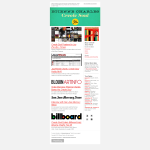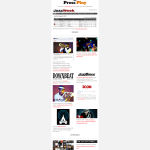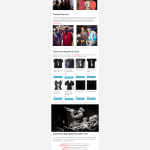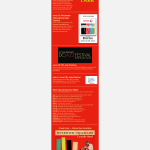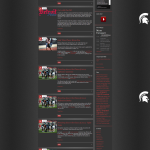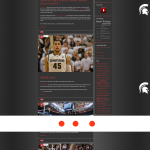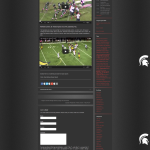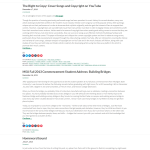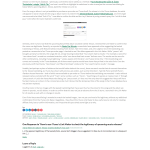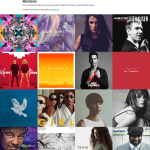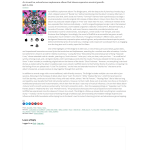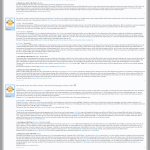After being asked to assist one of my jazz professors at Michigan State University, Etienne Charles, with social media promotion surrounding the release of his album Creole Soul, I created a series of email newsletters to keep fans updated of news, press coverage, and tour dates. Using MailChimp, I created custom newsletter designs based around the style of the Creole Soul album cover and accompanying graphics. I also created a press kit to be distributed to event and festival promoters, containing links to reviews and interviews.
music
I was contacted by the staff at Impact 89FM, the student radio station at Michigan State University, to build a sister site for the growing sports vertical being covered by staff online and on-air. After creating the site using WordPress Multisite, I adapted the design of the original, music-focused website, including a scoreboard section for easy access to campus sports results and a front-page layout that improved structure and readability for the faster-paced sports content.
I developed a personal website to discuss my interests in music, web development, and social media using WordPress, creating a custom theme focused on responsive design and clean typography. I included a custom post type for Reviews, as well as custom taxonomies for Artists and Record Labels that extend across the various types of content on the site. Original written content resulted in 16,000 pageviews during the first year of operation.
Built using the Less theme by Jared Erickson as a base.
I created The Voice Internet Radio in January 2011 as a platform to share my growing and increasingly varied tastes in music and encourage new music discovery with a like-minded community of music fans. Using the XenForo software, I built the forum, then created a custom forum theme to match the logo I had already created. Content architecture highlighted popular areas of the forum, including a streaming radio station, artist news and updates, and links to free, legal downloads.
These are one hundred songs that stayed in my heavy rotation throughout 2013. In a year that saw personal advancements including eight weeks studying abroad in France and graduation from college, these songs soundtracked my year, each song appealing to me through instrumentation, lyrics, or just its overall mood. Read on for descriptions of each track, access the whole playlist on SoundCloud to listen, and judge away.
Continue reading “Kurt’s 100 Favorite Songs of 2013”
Just over one month ago, Twitter launched its Twitter #Music website and iPhone app following the acquisition of music discovery site We Are Hunted. Now that the initial wave of hype and press coverage has dissolved, timelines have gone as quiet as before, with little adoption from industry figures or the general public and the app tumbling down iTunes app charts. Rather than declaring Twitter’s foray into a music service a flop so soon, however, I think there is still potential for Twitter #Music to become a useful and popular arm of the social network with a few changes and additions. Below are five suggestions that would provide more incentive for users and artists alike to continue using the platform to share and discover music.
1. Chart expansions: more genres, more services
Recently, Twitter #Music added ten genre-based charts to its existing Popular, Emerging, and Unearthed lists (along with new Superstars and Hunted charts). This is a good start for culling music into more specific subcategories, but additional charts could be used for more appropriate and in-depth classification. For example, the iTunes Store has 22 categories, including those like jazz, soul, and reggae that do not fit squarely into one of the ten pre-existing genres in #Music.
In addition to the genre charts, Twitter #Music’s five additional charts sort music of all genres based on popularity and virality, including those focused more on music discovery that helped We Are Hunted receive praise well before its acquisition. The original site also included a chart that displayed the Billboard Hot 100 with their own design and playback specifications. Reproducing such charts within the Twitter #Music experience would allow users to find and follow artists more easily, and since it has already built relationships with iTunes, Rdio, and Spotify, reframing theirs within the app would likely be a simplified process. This relationship could work both ways: charts could be saved or regularly published as Rdio and Spotify playlists (something that Billboard already does with Spotify, Rdio, and MySpace), encouraging users to visit streaming sites in addition to #Music. This would require the service to move past its one-song-per-artist ideology, however, which may explain the lack of a Billboard chart carried over from We Are Hunted to Twitter #Music.
2. Tastemaker discovery and recommendations
Much of the focus of the Twitter #Music experience is on artists. The search function only delivers results for artists; each artist is displayed with only one song, favoring the try-before-you-buy approach of offering one track with the option to dig further on another service at your own leisure; and the only Twitter users that can be followed are the artists themselves. With Twitter being inherently social, however, its music service would benefit from adapting the traits that have encouraged social activity by including a focus on end users as well. Interacting with fellow Twitter users between the social network and the music app is surprisingly a one-way street: tweets with the #nowplaying or #np hashtags get pulled into the #Music app, but #Music does not currently show Twitter users who have shared certain songs, and in order to see what another user is sharing within the app, the only option is to manually replace the username in the URL of a profile.
One such potential method of focusing on user interaction is in the artist listings throughout the app. Currently, no further data is presented beyond the artist and their chosen song. Why not bring Twitter users into the mix? Much like Twitter search results reveal users who are tweeting about a certain search term, clicking on an artist could display a timeline of the tweets including the artist and the #nowplaying (or #np) hashtag. Not only would this provide data about the fans of an artist, but it would give users more incentive to share music on Twitter, lending to the heard-it-first principle that powers music blogs and sites like TastemakerX.
Additionally, a central method for Twitter users to recommend artists to one another would be beneficial to music fans and musicians alike. Spotify and Rdio both offer this option already, but integrating a recommendation-sharing system within #Music with the potential to auto-tweet to users’ Twitter feeds and use Twitter Cards to link into the app would reach more users and likely provide higher engagement between all parties. As users discover music, direct sharing to friends would give them the appeal of being a tastemaker, while the inclusion of the artist’s Twitter handle in the recommendation would encourage and ease the act of following them.
3. Separate follow lists between Twitter and #Music
When first exploring Twitter #Music after its public release, I was excited to find that I could follow artists on the app without having them inserted into my Twitter timeline as well…or so I thought. Under the current setup, if I want to follow an artist’s music tastes in my Twitter #Music feed, I can only follow them on Twitter, with no ability to filter general tweets from those with music links. For artists that I only want to follow for their music taste, an additional follow option within Twitter #Music would allow such a separation. This would be beneficial in the same way for following users with good music recommendations as outlined in the previous paragraph, with the option to follow all of the tastemaker’s tweets on Twitter at each user’s own discretion.
4. Expand search beyond artists
As previously mentioned, Twitter #Music’s search option only displays results for artists, with no option to search songs, users, or tweets. Should the details of users’ tweets be included in a future update to the app, an expanded search would enable users to find music based on certain search terms and hashtags. Much like Songza offers a “Music Concierge” option for curation based on a given day and mood, searching for “#musicmonday” or “study music” could offer the same results on Twitter, with curation provided by users rather than being programmed by developers. In the same way, music curated around trends based on current events could provide a soundtrack to the day. While #nowplaying and #np are good choices for Twitter #Music to begin sorting tweets, a search expansion would allow users to define their own methods for filter music and discover artists based on more specific criteria.
5. Connect to more artists and audio services
First created in September 2011, the @TwitterMusic department has worked with artists to get them on Twitter and to use the platform for connecting with users and marketing new projects, among other things. However, there are still a few noticeable gaps with artists who have yet to join the social network. For example, while the buzz for Daft Punk has grown to a deafening roar up to this week’s album release, they are completely invisible on Twitter #Music, regardless of how much they are being properly shared by users, merely because they do not have an official presence on the site. While it is extremely implausible to suggest all artists will join Twitter, the Twitter #Music app could compensate for missing artists by providing a basic profile with data sourced from iTunes, which could be filled out if the artist joined Twitter at a later date. This would ensure the accuracy of the app’s charts even despite artists missing from the service, and might even encourage artists to sign up for Twitter to benefit from the additional exposure on the app.
While it would require creating additional partnerships, #Music would also benefit from adding more audio services for users to stream content. In particular, We Are Hunted sourced its audio from SoundCloud before it was acquired by Twitter, so its absence is somewhat peculiar. Unlike Spotify and Rdio, SoundCloud does not require a subscription for users to stream full audio, which would make music easier to hear through the app should it be included as well. The addition of Amazon MP3 as a retailer and streaming services like MOG, VEVO, and YouTube would also improve user accessibility to the music shared within the app. Naturally, deals with record labels would have to be reached beforehand, which is likely causing the current delay in adding such options.
With limited adoption and a lack of updates to the service thus far, many people have already written off Twitter #Music as a failure. However, with only a month of history written since its public release, there is still a long path of progress before #Music, making it unnecessary to throw in the towel so soon. In the same way, it took time for Twitter itself to grow and build its now-massive membership. Updates including additional social integration, search capabilities, and compatibility with new music services would help Twitter’s newest service to become more accessible, user-friendly, and functional for music discovery. Despite the death bells already ringing, Twitter #Music isn’t dead just yet — for now, let the music play.
UPDATE: Buy “It’s A Beautiful Day” on iTunes!
After weeks of subtle hints that new music was on its way, Michael Bublé and his team at Warner Bros. Records released a trio of teaser videos over the past week that previewed the lead single from his upcoming sixth studio album. Though all three videos were short, the audio revealed happy thematic elements and upbeat, bouncy production closely resembling that of his hit released in 2009, “Haven’t Met You Yet.”
Now that all three video previews have been released, with the third being posted early Tuesday afternoon, Bublé is set to premiere his new single, “It’s A Beautiful Day,” which will be revealed on michaelbuble.com sometime later today (Wednesday). Continue reading “Getting a sneak peek at Michael Bublé’s “Beautiful Day””
Next week, Phoenix will rise from the ashes…with new music.
After reaching new levels of success with “1901” and “Lisztomania” from their fourth album, 2009’s Wolfgang Amadeus Phoenix, the rock quartet from Versailles, France has spent the past two years working on its followup. Earlier this week, the band announced that Bankrupt! would be released during the week of April 22 by Glassnote Records and the band’s imprint, Loyauté, with an international release from V2 Records. The announcement of the album’s release date was accompanied with the album cover, its tracklist, and a short text-based video featuring audio from the track “Bourgeois.”
Continue reading “Phoenix to release Bankrupt! lead single “Entertainment” on Monday”
Depeche Mode recently announced the upcoming release of their 13th studio album, Delta Machine, to be released on March 26, featuring lead single “Heaven.” To prepare for the new album era, the band has partnered with Eyes & Ears Entertainment to put up a countdown site that has currently revealed tour dates and album information, as well as a new Tumblr blog for the band. In contrast to this month’s earlier high-profile countdown for Justin Timberlake’s single “Suit & Tie” (whose website was created by Eyes & Ears partner Uprising Creative), Depeche Mode has already revealed the names of the album and single that will be released, as well as their release dates: before the March 26 release of Delta Machine, “Heaven” will be released as a two-track single (with B-side “All That’s Mine,” which will also be available on the deluxe edition of Delta Machine) and in a five-track remix EP on Friday, February 1. The video for “Heaven” will also premiere the same Friday on VEVO.
Continue reading “Analyzing the microsite for Depeche Mode’s new single “Heaven””
UPDATE (Monday): I’m pleased to find out that the predictions in this post were correct, as announced on Justin Timberlake’s website. Buy “Suit & Tie,” from The 20/20 Experience, on iTunes: http://kwn.me/suitandtie
On Thursday at 9:01 AM Pacific time, Justin Timberlake‘s name spread like wildfire across social media and news sites, just as if we had stepped back in a time machine to 2002, with the revelation of a countdown that would all but certainly end with a new single and album from the former *NSYNC member. While the teaser video and website gave no clear indication of the project’s names, a few clues have appeared that indicate a title of “Suit & Tie” for the lead single from forthcoming album The 20/20 Experience. Read on for an explanation of these clues and feel free to draw your own conclusions — none of this information is confirmed yet.
Continue reading “20/20 Vision: cracking the code of Justin Timberlake’s countdown”
